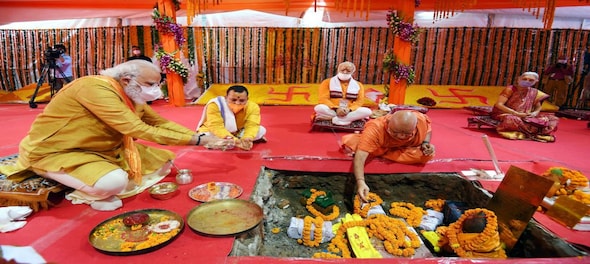
In a fortnight from now, the country will witness a grand event at Ayodhya, the consecration of Ram Temple amid a set of special invitees in attendance who are expected to arrive at this township in Uttar Pradesh.
The January 22 event being organised by the Ram Janmabhoomi Trust has sent out invitations for the ceremony where Prime Minister Narendra Modi, Rashtriya Swayamsevak Sarsanghchalak Mohan Bhagwat, Uttar Pradesh Governor Anandiben Patel, State Chief Minister Yogi Adityanath and the Trust Chief Mahant Nritya Gopal Das would be the Chief Guests.
Earlier, this week reports appeared on the grandiose plans drawn by the Bharatiya Janata Party to facilitate the visit of thousands of pilgrims to the temple city from January 25 onwards. These include a series of special trains with party workers providing ground support to those desirous of undertaking the journey and pay respects at the newly constructed Ram Temple.
A week ahead of the inauguration, the BJP decided to send its karyakartas (volunteers) to clean the city and make it ready for the event and continue to engage in the activity till about the time visitors and pilgrims start descending there.
Earlier, on his part Prime Minister Narendra Modi suggested that January 22 should be celebrated as Deepavali with homes in every part of the country lighting diyas (lamps), symbolising the return of Lord Ram to Ayodhya. The BJP workers will join hands across the country to make it successful, portraying it as a manifestation of people rejoicing over the completion of the temple and Pran Pratistha (consecration).
In the run up to the event, RSS workers have been distributing Akshat (raw rice mixed with oil and turmeric powder) that is traditionally sprinkled to bless people after performing religious ceremonies and considered auspicious.
As per estimates prepared by the BJP, the 60-day plan to take pilgrims to Ayodhya could result in arrival of some 50,000 people daily which should roughly translate into 30 lakh people having undertaken the journey by the end of this period.
The BJP perceives that while the effort should be viewed from the prism of religion and culture and peoples abiding faith, yet the party would want its decades long push for the temple to remain etched in the memory of people.
After all, the Ram Janmabhoomi andolan acquired political undertones during the late 1980s when the BJP adopted the Vishwa Hindu Parishad’s demand for a temple, passed a resolution at its Palampur convention in 1989 in its support and also to back litigation by Hindutva parties. Later that year, Lal Krishna Advani embarked on a Rath Yatra; the presence of leaders from the BJP, it's frontal organisations and those of RSS-family when karsewaks tore down the Babri Masjid; and decades of prolonged legal battle that culminated after the Supreme Court gave its verdict on the dispute are string in the long thread in which the party remains in the core.
With the country entering the home stretch to elect a new government this summer, the BJP will want to consolidate its pole position that it did not waver from its ideological commitment. Among the three major issues, construction of Ram Temple, removal of Article 370 have been accomplished with the last one Uniform Civil Code remaining.
The fruition of Ram Temple is certainly a high point in the list of tasks that remained enmeshed for decades. Construction of a temple at Ayodhya fulfils the promise that the BJP has been making in successive election manifestos.
Yet, during the first two tenures of the Atal Behari Vajpayee government, the BJP kept the three issues aside, bowing to the demands of coalition partners. This change of strategy followed the near-total political isolation of the BJP in 1996 — when PM Vajpayee could not garner support following its pronounced Hindutva stance.
Now during the last decade, the political landscape in the country has undergone a change. The BJP has trained its sights to ensure the return of Modi Sarkar, for a third term. The result will allow the party and PM Modi to equal the record of India's first PM Jawaharlal Nehru who won three consecutive terms since 1951 general elections.
PM Modi remains the central pillar around which the BJP will campaign to project how the party delivered on its ideological, political and economic commitments while enhancing the prestige of the country in the global order and offering a roadmap during Amrit Kaal.
—The author, K V Prasad, is an author and political analyst. The views expressed are personal.
Read his previous articles here
(Edited by : C H Unnikrishnan)
First Published: Jan 8, 2024 12:30 PM IST
Check out our in-depth Market Coverage, Business News & get real-time Stock Market Updates on CNBC-TV18. Also, Watch our channels CNBC-TV18, CNBC Awaaz and CNBC Bajar Live on-the-go!


Just 8% women candidates contested first two phases of Lok Sabha polls
Apr 29, 2024 12:00 PM
The sexual assault case against Prajwal Revanna — here's what we know so far
Apr 29, 2024 11:36 AM
Repolling underway at one polling booth in Chamarajanagar LS segment in Karnataka
Apr 29, 2024 10:32 AM

